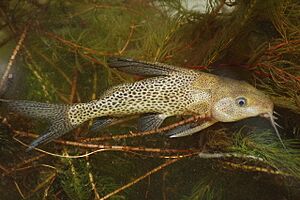Synodontis woosnami facts for kids
Quick facts for kids Synodontis woosnami |
|
|---|---|
 |
|
| Conservation status | |
| Scientific classification | |
| Genus: |
Synodontis
|
| Species: |
woosnami
|
The Synodontis woosnami, also called the Upper Zambezi squeaker or bubblebarb squeaker, is a type of upside-down catfish. This fish lives in parts of Angola, Botswana, Namibia, Zambia, and Zimbabwe. You can find it in the upper Zambezi River and Okavango River areas, as well as the Cunene River.
A British-Belgian zoologist named George Albert Boulenger first described this fish in 1911. He found the first one in the Okavango River in Botswana. The name woosnami comes from R. B. Woosnam, who collected that first fish.
About the Upper Zambezi Squeaker
Like all Synodontis fish, the S. woosnami has a strong, bony head. This head bone goes all the way back to its first fin spine. Its head also has a special bony part called a humeral process. The shape of this part helps scientists tell different Synodontis species apart. For the S. woosnami, this bony part is a bit longer than it is wide. It does not have a sharp point at the end.
This fish has three pairs of barbels, which are like whiskers. One pair is on its upper jaw. Two pairs are on its lower jaw. The upper jaw barbels are long and straight. They do not have branches. These barbels are about four-fifths the length of its head. The lower jaw barbels have thin branches. The outer pair is about one and a half times longer than the inner pair.
The front edges of the dorsal fin (on its back) and pectoral fins (on its sides) are stiff spines. The spine on its back fin is about five-sixths the length of its head. It is slightly curved. This spine is smooth on the front and rough on the back. The rest of the dorsal fin has seven soft rays. The pectoral fin spine is as long as the dorsal spine. It is rough on both sides.
The S. woosnami also has an adipose fin. This is a small, fleshy fin without rays. Its anal fin has four unbranched rays and eight branched rays. This fin looks rounded. Its tail, or caudal fin, is deeply forked.
All Synodontis fish have a special pad of teeth on their upper jaw. This is called a premaxillary toothpad. It has several rows of short, chisel-shaped teeth. In S. woosnami, this toothpad is short and wide. On its lower jaw, the teeth are attached to flexible, stalk-like parts. These teeth are described as "s-shaped" or "hooked." The number of teeth on the lower jaw helps identify the species. The S. woosnami has about 20 teeth on its lower jaw.
The main color of this fish is dark brown on its back. Its underside is lighter. Its back, sides, and fins are covered with black dots.
The biggest S. woosnami ever measured was about 20.5 centimeters (8.1 inches) long. Female Synodontis fish are usually a bit larger than males of the same age.
Habitat and Life Cycle
In the wild, the S. woosnami lives in the upper Zambezi River basin. It also lives in the Okavango River basin and the Cunene River basin.
Scientists do not know much about how most Synodontis species reproduce. We know that females can carry many eggs. They likely lay their eggs during the flooding season. This usually happens between July and October. Pairs of fish probably swim together when they lay eggs.
Synodontis fish are omnivores. This means they eat both plants and animals. They eat insect larvae, algae, snails, clams, sponges, and small crustaceans. They also eat the eggs of other fish. These fish grow quickly in their first year. Then their growth slows down as they get older.


